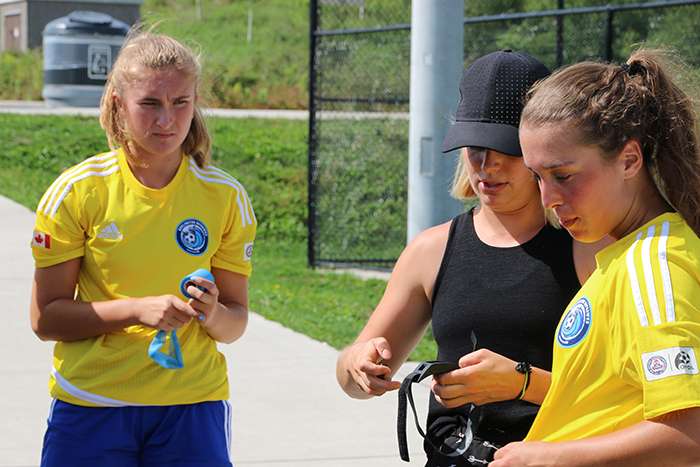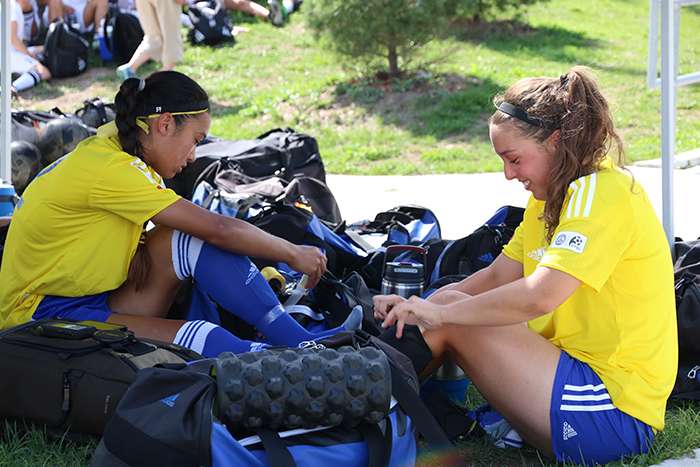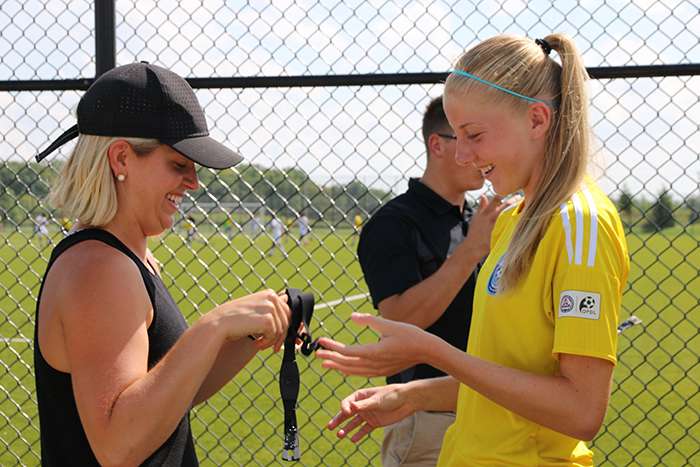Study draws attention to female athletes, concussion

It's a dangerous epidemic in contact sport, a little-studied problem that slid under the radar for decades. And while research surrounding sport-related concussions has gained momentum in recent years, studies have mainly focused on males in contact-heavy sports, like football and hockey. Meanwhile, females in less contact-heavy sports, like soccer, have received much less attention.
That's a significant oversight, according to a team of Western researchers.
Alexandra Harriss, a Health Sciences PhD student, has been working with the Ontario Player Development League and Burlington Youth Soccer Club to study the relationship between accumulated head impact exposures in female youth soccer players, between the ages of 13-15. Using specialized sensors players wear as headbands, Harriss is looking for changes in brain function that occur as a result of head-to-head, head-to-ground and head-to-ball impacts during practice and game play.
"With every sport, there's an inherent risk of injury, whether it's a knee injury or ankle injury. With head injury in sport, we are trying to manage that risk," said Harriss, who is conducting her work under the co-supervision of Health Sciences professors Jim Dickey and Dave Walton.
"Being able to isolate our study to the female team was a great opportunity. With youth, their brains are still maturing. There's huge research going right now with head musculature and head strength – and girls have reduced neck strength compared to males. That might be a perpetuating factor (for injury), especially when they are going to head the ball," she said.

The specialized headbands Harriss is using contain GForceTracker micro-sensors that fit at the base of the player's head. At the start of the season, earlier this summer, Harriss evaluated each players' baseline electroencephalogram (EEG) and then, throughout the season, has tracked all impacts they received during both practices and games.
"We are looking to understand lower impacts and how they can affect brain function over time. With the headbands, we can quantify the magnitude of those head impacts. We can see it in real-time; it's transmitted to a sideline viewer. We can tell right away the amount of force exerted with that impact," Harriss explained.
In addition to the initial EEG, players received two mid-season evaluations. They will have a final EEG measure at the end of the season in October.
The nature of head impacts in soccer is different than in football and hockey, where players wear helmets, making this study especially pertinent. The ultimate goal of the study is to understand the effects of repeated head impacts and potentially reduce the risk of injury for players.
"For instance, if we find heading is a risk to these players, is it due to proper form they aren't carrying out? If that's true, then how do we make sure these players are heading the ball properly to reduce the amount of force exerted? We've learned that proper heading technique does matter," she said.

"A player that is ready for the ball and meets the ball at the forehead is going to have a reduced amount of force than a player who hits the ball on top of the head or in an unanticipated contact."
Craig Clydesdale, who coaches the U15 team, one of three teams Harriss has been working with, said his team could not pass on the opportunity to participate in the study. Its potential findings resonated with the players.
"We lost a player to a concussion this year. She was running and tripped and fell, bumped her head on the ground. She's been out for the entire season because of a concussion. It is real. Any activity, any sport you play, you run that risk. So if there's anything we can do to know more about it, to reduce the risk, that's a good thing," said Clydesdale, who has been coaching soccer for 30 years.
"In the history of coaching and concussions, there has been a lot of misinformation. To be able to be part of a study to get some accurate information will help us going forward."
At a recent game, his team of 15-year-olds was visibly enthusiastic about the study, gathering with Harriss at the start, grabbing headbands, ensuring they were wearing sensors properly. Players were able to look at the data on the sidelines, too. Player Michelle Starkell called it "a cool opportunity to see how heading impacts them."
Sport-related concussions aren't "the unknown" they once were, added Lynne Schleischkorn, U15 team manager and mom of one of the players. Having four active daughters, Harriss' study is especially important to her.
"My second daughter, who is now coaching, played high school sports and had many concussions. Even teachers were not in tune, didn't react the way we would now. Now, it's a lot about readjustments. The girls, the parents have more information, the coaches as well. They don't take chances like they used to, and that's important," Schleischkorn noted.
"My (daughter on the team) has seen my second daughter be severely hurt in concussions, so she's really sensitive to this. It's important. If somehow things can change for the better, she feels it's important and that it's a privilege to be part of this."



















